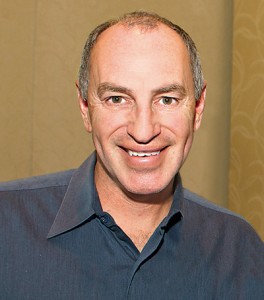The “Bigger is Better” approach to DTC campaigns is taking a backseat to DTP, which puts the emphasis on engaging the patient.
“She held my father’s hand when she spoke to him, she walked with him in the halls when he was strong enough to get out of bed, and she even held his hand during painful and scary procedures,” recalls Sandrine. “And Dr. Klimek told us that this is going to be a team effort and that our family was as much a part of his recovery as she was. We were immediately reassured by her confidence.” —Sandrine Belier on the care that her father received from his oncologist, Virginia Klimek, MD
With the everyday pressures of meetings, deadlines, budget management, sales forecasts and the business of pharmaceutical marketing, it’s easy to forget that it all boils down to one very simple thing: As you read this article, millions of patients are living with and managing a whole variety of conditions. The one thing all those patients have in common is that they have some type of relationship with their healthcare professional. A huge opportunity exists for pharmaceutical marketers to enhance patient/HCP dialogue, to deliver better, more compassionate care for patients, which positively impacts both NRx and TRx for brands.
Healthcare direct-to-consumer (DTC) marketing has historically embraced a “bigger is better” approach to communications built around using multiple channels to raise awareness and drive sales among the masses. However, healthcare DTC trends are shifting as budget pressures, market dynamics, regulatory issues, managed care and savvy consumers impose a new set of standards for effective healthcare DTC marketing.
“The days of going wide with marketing strategies should be out the door. States, payers, and even health systems are creating a dynamic where large scale campaigns will not work universally. Successful marketing campaigns, with strong ROI, should evolve around marketing strategies that are targeted in their design.
For example: Brand A receives preferred formulary status, although the plan has lives across the U.S., the majority of lives are in the greater Northeast. To be effective, the creation of campaign tools geared towards that geography should be part of your strategic marketing efforts and should include helpful resources such as local pharmacy addresses and co-pay information at those pharmacies.”
—Brian Fields, former Pfizer brand manager, currently strategic marketing consultant, Pfizer
The mass market approach to healthcare DTC has taken a backseat to a more focused, cost-effective direct-to-patient (DTP) strategy that makes engaging the patient the highest priority.
The most efficient way to accomplish this is by facilitating a productive dialogue between patients and their healthcare providers, since this is where disease-state information is communicated, options are discussed and treatment plans are put in place.
“After working with my doctor to develop a treatment plan that includes both preventative and acute medications, my migraines dropped from more than 15 per month to just four or five.” —Patient Tina B.
Smart DTP marketers are recognizing that simply raising awareness rarely offers the firepower needed to ignite action that leads to better healthcare outcomes. DTP trends will continue to push past the old school awareness-raising approach in favor of using strategies and tactics that not only engage the patient, but also offer valuable, “actionable” patient education tools for healthcare providers to use in their practices.
Effective DTP efforts will break down the emotional and behavioral barriers that too often short-circuit treatment plans. As we know, brands often face huge condition gaps in motivating patients. Consistent and ongoing educational efforts can address this, particularly at the point of care and when reaching targeted patients in their homes.
Emerging Trends
“Targeting the right individual at the right time with the right message is the goal of most marketers. The appropriate message, including a motivational call to action at point of care can trigger patients to engage physicians in dialogue about a given disease state and hopefully specific products and benefits.” —Paul Stevenson, Associate Director, Levemir, Diabetes Marketing Novo Nordisk, Inc.
So what do patients want and need to solve the healthcare issues that are literally and figuratively keeping them up at night and how can pharma successfully satisfy those needs? First and foremost, patients need relevant, credible, actionable and complete information that will help them map out a treatment plan to enhance both the quality of their lives, as well as address the underlying condition. They need info that inspires hope that they can have a successful outcome.
“I’m so grateful for my health and renewed quality of life [since my diagnosis]. And I won’t let hip pain stop me from living the life I want.” —Leslie Sandler, dancer with osteoarthritis of the hip
The most trusted source of that information often comes from their HCPs. The growing challenge is the shortage of face-to-face time that HCPs have with their patients. DTP communications that make it easy and efficient for HCPs to provide the necessary information to help patients is crucial since it will save HCPs’ time. Smart marketers can create communication vehicles that help HCPs deliver critical education in the office, through collateral materials the patient can take away and HCP/patient discussion guides. Using credible third-party sources that patients can connect with and trust is a key tool in the DTP toolkit. Here is a real life example:
“I have been diagnosed with Stage IV prostate cancer now for a little over a year. When first diagnosed, my urologist gave me a paperback book about prostate cancer, but it did not help me. Yesterday I had a monthly appointment with my doctor and I picked up a guide to living with prostate cancer while in the waiting room, and I knew right away I had found a real asset. The advertisement on Xgeva also increased my knowledge and understanding of that.” —Patient Ron
The challenge with materials created by pharma manufacturers is that patients and doctors view them with skepticism. The opportunity for pharma marketers is to partner with KOLs, patient advocates, associations, advocacy groups and celebrity spokespeople with a real connection to a disease state. These partnerships create great opportunities for collaboration.
Whatever the source, it’s important to make sure the content inspires trust, offers insight and ideas on the best ways to manage the disease state and comes from someone the patient can relate to.
Larry King, former CNN news anchor on diabetes:
“Diabetes is a silent killer. Once you have diabetes, knowledge is a great protector. Good information is readily available. Take advantage of that. The more you know, the better off you are.”
Giving patients information that is relevant to them wherever they are on the treatment continuum is critical. DTP marketers must be the curators of patient education that promotes productive patient/HCP dialogues in a logical sequence timed to address patient questions and needs at different points throughout the treatment program. The questions a patient might have when diagnosed with a disease are likely to be very different from questions that arise during the course of treatment and when the patient shifts to maintenance mode.
Engagement
All of the information offered, and when and how it is delivered, promotes patient engagement at every point on the treatment continuum, and chips away at the emotional and behavioral barriers that can disrupt adherence. Communication tactics that deliver the greatest impact are ones that can be used at the point of care when and where the patient is most likely to take action. When patients are in the doctor’s office, they are focused on their issue, prepared to talk to their doctors and ready to find solutions to manage their health. Doctor/patient discussion guides that include answers to frequently asked questions, treatment options and other vital information empower the patient to make the most of their time with their HCP.
DTC marketing has one objective—to empower a patient to drive a productive dialogue with their HCPs about their condition and the role that therapies may play in their treatment plan. When you look at investment, two things are striking: providing the patient with enough information (and hope) to empower action, and activating a maximum number of those selective patients with the budget you have. POC helps achieves both.
—Joe Hoholick, Executive Director, DTC Marketing, Amgen
Sending patients home with materials builds on the momentum generated during the doctor/patient dialogue and helps keep patients engaged in their treatment program. The most important element is to make sure patients feel as if the resources they are given have the implied and/or direct endorsement of their HCP.
Trends in DTP marketing will continue to be driven by motivating patients to work with their HCPs to create a treatment plan that patients will stick with throughout the course of treatment to get the best possible outcomes. Keeping the patients’ needs first and foremost and facilitating the patient/HCP dialogue is the bedrock for successful DTP. This approach not only supports the efforts of the HCP and enhances the quality of care for patients, it also boosts pharma’s marketing ROI. Third-party research consistently shows that when pharma companies place a branded advertisement around high-quality, third-party patient education, it can have a significant impact on both NRx and TRx.
Six Best DTP Practices
1. Leverage the power of point of care when patients are most likely to take action.
2. Offer actionable patient education tools for HCPs to use in their practices.
3. Deliver information in a logical sequence timed to address patient questions and needs at different points throughout the treatment program.
4. Fill in information gaps that exist with various conditions to educate and empower patients.
5. Customize content to reflect regional, demographic and seasonal factors.
6. Give patients information that inspires hope for a successful outcome.








